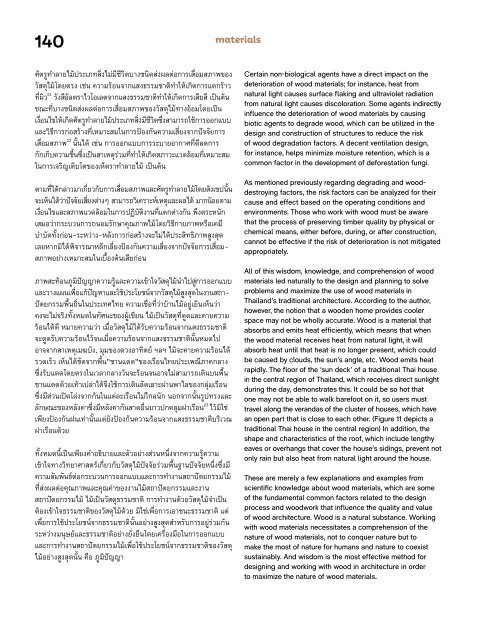ASA JOURNAL 14/2023
You also want an ePaper? Increase the reach of your titles
YUMPU automatically turns print PDFs into web optimized ePapers that Google loves.
<strong>14</strong>0<br />
materials<br />
ศัตรูทำาลายไม้ประเภทสิ่งไม่มีชีวิตบางชนิดส่งผลต่อการเสื่อมสภาพของ<br />
วัสดุไม้โดยตรง เช่น ความร้อนจากแสงธรรมชาติทำาให้เกิดการแตกร้าว<br />
ที่ผิว 21 รังสีอัลตราไวโอเลตจากแสงธรรมชาติทำาให้เกิดการเสียสี เป็นต้น<br />
ขณะที่บางชนิดส่งผลต่อการเสื่อมสภาพของวัสดุไม้ทางอ้อมโดยเป็น<br />
เงื่อนไขให้เกิดศัตรูทำาลายไม้ประเภทสิ่งมีชีวิตซึ่งสามารถใช้การออกแบบ<br />
และวิธีการก่อสร้างที่เหมาะสมในการป้องกันความเสี่ยงจากปัจจัยการ<br />
เสื่อมสภาพ 22 นั้นได้ เช่น การออกแบบการระบายอากาศที่ดีลดการ<br />
กักเก็บความชื้นซึ่งเป็นสาเหตุร่วมที่ทำาให้เกิดสภาวะแวดล้อมที่เหมาะสม<br />
ในการเจริญเติบโตของเห็ดราทำาลายไม้ เป็นต้น<br />
ตามที่ได้กล่าวมาเกี่ยวกับการเสื่อมสภาพและศัตรูทำ าลายไม้โดยสังเขปนั้น<br />
จะเห็นได้ว่าปัจจัยเสี่ยงต่างๆ สามารถวิเคราะห์เหตุและผลได้ มากน้อยตาม<br />
เงื่อนไขและสภาพแวดล้อมในการปฏิบัติงานที่แตกต่างกัน พึงตระหนัก<br />
เสมอว่ากระบวนการถนอมรักษาคุณภาพไม้โดยวิธีกายภาพหรือเคมี<br />
บำาบัดทั้งก่อน-ระหว่าง-หลังการก่อสร้างจะไม่ได้ประสิทธิภาพสูงสุด<br />
เลยหากมิได้พิจารณาหลีกเลี่ยงป้องกันความเสี่ยงจากปัจจัยการเสื่อม-<br />
สภาพอย่างเหมาะสมในเบื้องต้นเสียก่อน<br />
ภาพสะท้อนภูมิปัญญาความรู้และความเข้าใจวัสดุไม้นำาไปสู่การออกแบบ<br />
และวางแผนเพื่อแก้ปัญหาและใช้ประโยชน์จากวัสดุไม้สูงสุดในงานสถา-<br />
ปัตยกรรมพื้นถิ่นในประเทศไทย ความเชื่อที่ว่าบ้านไม้อยู่เย็นเห็นว่า<br />
คงจะไม่จริงทั้งหมดในทัศนะของผู้เขียน ไม้เป็นวัสดุที่ดูดและคายความ<br />
ร้อนได้ดี หมายความว่า เมื่อวัสดุไม้ได้รับความร้อนจากแสงธรรมชาติ<br />
จะดูดรับความร้อนไว้จนเมื่อความร้อนจากแสงธรรมชาตินั้นหมดไป<br />
อาจจากสาเหตุเมฆบัง, มุมของดวงอาทิตย์ ฯลฯ ไม้จะคายความร้อนได้<br />
รวดเร็ว เห็นได้ชัดจากพื้น”ชานแดด”ของเรือนไทยประเพณีภาคกลาง<br />
ซึ่งรับแดดโดยตรงในเวลากลางวันจะร้อนจนอาจไม่สามารถเดินบนพื้น<br />
ชานแดดด้วยเท้าเปล่าได้จึงใช้การเดินลัดเลาะผ่านพาไลของกลุ่มเรือน<br />
ซึ่งมีส่วนเปิดโล่งจากกันในแต่ละเรือนไม่ไกลนัก นอกจากนั้นรูปทรงและ<br />
ลักษณะของหลังคาซึ่งมีหลังคากันสาดยื่นยาวปกคลุมฝาเรือน 23 ไว้มิใช่<br />
เพียงป้องกันฝนเท่านั้นแต่ยังป้องกันความร้อนจากแสงธรรมชาติบริเวณ<br />
ฝาเรือนด้วย<br />
ทั้งหมดนี้เป็นเพียงคำาอธิบายและตัวอย่างส่วนหนึ่งจากความรู้ความ<br />
เข้าใจทางวิทยาศาสตร์เกี่ยวกับวัสดุไม้ปัจจัยร่วมพื้นฐานปัจจัยหนึ่งซึ่งมี<br />
ความสัมพันธ์ต่อกระบวนการออกแบบและการทำางานสถาปัตยกรรมไม้<br />
ที่ส่งผลต่อคุณภาพและคุณค่าของงานไม้สถาปัตยกรรมและงาน<br />
สถาปัตยกรรมไม้ ไม้เป็นวัสดุธรรมชาติ การทำางานด้วยวัสดุไม้จำาเป็น<br />
ต้องเข้าใจธรรมชาติของวัสดุไม้ด้วย มิใช่เพื่อการเอาชนะธรรมชาติ แต่<br />
เพื่อการใช้ประโยชน์จากธรรมชาตินั้นอย่างสูงสุดสำาหรับการอยู่ร่วมกัน<br />
ระหว่างมนุษย์และธรรมชาติอย่างยั่งยืนโดยเครื่องมือในการออกแบบ<br />
และการทำางานสถาปัตยกรรมไม้เพื่อใช้ประโยชน์จากธรรมชาติของวัสดุ<br />
ไม้อย่างสูงสุดนั้น คือ ภูมิปัญญา<br />
Certain non-biological agents have a direct impact on the<br />
deterioration of wood materials; for instance, heat from<br />
natural light causes surface flaking and ultraviolet radiation<br />
from natural light causes discoloration. Some agents indirectly<br />
influence the deterioration of wood materials by causing<br />
biotic agents to degrade wood, which can be utilized in the<br />
design and construction of structures to reduce the risk<br />
of wood degradation factors. A decent ventilation design,<br />
for instance, helps minimize moisture retention, which is a<br />
common factor in the development of deforestation fungi.<br />
As mentioned previously regarding degrading and wooddestroying<br />
factors, the risk factors can be analyzed for their<br />
cause and effect based on the operating conditions and<br />
environments. Those who work with wood must be aware<br />
that the process of preserving timber quality by physical or<br />
chemical means, either before, during, or after construction,<br />
cannot be effective if the risk of deterioration is not mitigated<br />
appropriately.<br />
All of this wisdom, knowledge, and comprehension of wood<br />
materials led naturally to the design and planning to solve<br />
problems and maximize the use of wood materials in<br />
Thailand’s traditional architecture. According to the author,<br />
however, the notion that a wooden home provides cooler<br />
space may not be wholly accurate. Wood is a material that<br />
absorbs and emits heat efficiently, which means that when<br />
the wood material receives heat from natural light, it will<br />
absorb heat until that heat is no longer present, which could<br />
be caused by clouds, the sun’s angle, etc. Wood emits heat<br />
rapidly. The floor of the ‘sun deck’ of a traditional Thai house<br />
in the central region of Thailand, which receives direct sunlight<br />
during the day, demonstrates this. It could be so hot that<br />
one may not be able to walk barefoot on it, so users must<br />
travel along the verandas of the cluster of houses, which have<br />
an open part that is close to each other. (Figure 11 depicts a<br />
traditional Thai house in the central region) In addition, the<br />
shape and characteristics of the roof, which include lengthy<br />
eaves or overhangs that cover the house’s sidings, prevent not<br />
only rain but also heat from natural light around the house.<br />
These are merely a few explanations and examples from<br />
scientific knowledge about wood materials, which are some<br />
of the fundamental common factors related to the design<br />
process and woodwork that influence the quality and value<br />
of wood architecture. Wood is a natural substance. Working<br />
with wood materials necessitates a comprehension of the<br />
nature of wood materials, not to conquer nature but to<br />
make the most of nature for humans and nature to coexist<br />
sustainably. And wisdom is the most effective method for<br />
designing and working with wood in architecture in order<br />
to maximize the nature of wood materials.


















